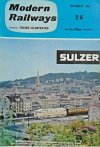The big change came in 1961, when the service was dieselised, and put on a (semi) even interval basis. Broadly the new 6-car Trans-Pennine dmus were put onto a two-hour interval service all day between Liverpool and Hull, while Liverpool to Newcastle services were dieselised with Class 46 Peaks allocated to Newcastle, run at the intervening hours to give an even hourly service morning and afternoon between Liverpool and Leeds. As stated above, there were two morning trains and two evening trains from each end, locos and stock making a single round trip. At this early stage the Manchester station served was still Exchange, after some years that was closed and they moved along the platform (literally) to Victoria.
By chance the second morning train was always in Liverpool Lime Street preparing for departure when the daily Liverpool to Plymouth (via Taunton) train left, and later the first such afternoon train was ready to go when the Plymouth service returned us there. It was always a Gateshead Peak, but I've read enough accounts that Class 40s were regulars on this run as well to accept that too, maybe the other services, or different years. This pattern did seem to last for about 20 years. There were some fill-in services at the ends of the day and in the mid-day gaps that covered part of the route. One of the Trans-Pennine units only worked as far as Manchester in the early afternoon, and then took up the key commuter service of the day to Blackpool, returning next morning.
The Trans=Pennine units were theoretically fixed sets, but individual cars seemed somewhat unreliable, if one of the intermediates it would just be left out, while the end cars were sometimes replaced by a Met-Cam low density power car, which always looked a bit odd. I think it must have been 1965 and, visiting Manchester Exchange by chance, what should come in on one of the westbound loco-hauled expresses but an A1 Pacific, even at this late stage. I can't tell you any more about which service, or if it went right through to Liverpool.

 . On we went to Liverpool where there was D166 waiting to depart on the 5pm for Newcastle, still shiny and new.
. On we went to Liverpool where there was D166 waiting to depart on the 5pm for Newcastle, still shiny and new.